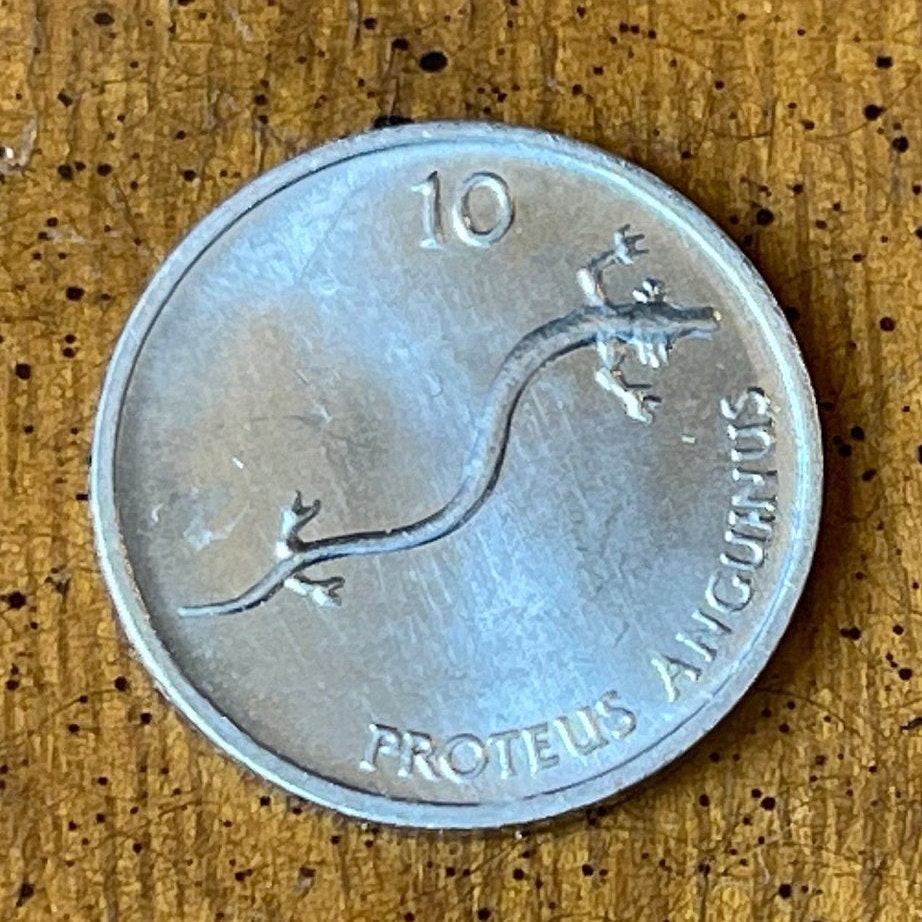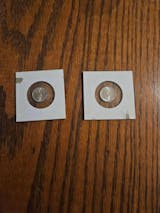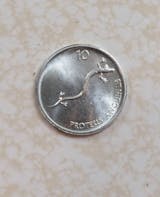elemintalshop
Salamander 10 Deset Slovenia Authentic Coin Money for Jewelry and Craft Making
Salamander 10 Deset Slovenia Authentic Coin Money for Jewelry and Craft Making
Couldn't load pickup availability
Salamander 10 Deset Slovenia Authentic Coin Charm for Jewelry and Craft Making
Reverse
A proteus (salamander), a salamander that retains larval characteristics (gills) and lives in Karstic caves in Slovenia, Croatia and Bosnia-Herzegovina, which is comparable to the Mexican axolotl, with its name in Latin below and the value in numerals above
Lettering:
10
PROTEUS ANGUINUS
Translation:
10
Salamander
Obverse
The value in numerals in an embossed square in the centre with the country name to the left, and the value in Slovenian along with the date to the right
Lettering:
REPUBLIKA SLOVENIJA
DESET STOTINOV
Translation:
Republic of Slovenia
Ten Stotinov
Features
Issuer Slovenia
Period Republic (1991-date)
Type Standard circulation coin
Years 1992-2006
Value 10 Stotinov (0.10 SIT)
Currency Tolar (1991-2006)
Composition Aluminium-magnesium (98% Aluminium, 2% Magnesium)
Weight 0.55 g
Diameter 16 mm
Thickness 1.3 mm
Shape Round
Technique Milled
Orientation Medal alignment ↑↑
Demonetized 15 January 2007
Number N# 2143
References KM# 7
Wikipedia:
The olm is a symbol of Slovenian natural heritage. The enthusiasm of scientists and the broader public about this inhabitant of Slovenian caves is still strong 300 years after its discovery. Postojna Cave is one of the birthplaces of biospeleology due to the olm and other rare cave inhabitants, such as the blind cave beetle. The image of the olm contributes significantly to the fame of Postojna Cave, which Slovenia successfully utilizes for the promotion of ecotourism in Postojna and other parts of Slovenian karst. Tours of Postojna Cave also include a tour around the speleobiological station – the Proteus vivarium, showing different aspects of the cave environment.
The olm was also depicted on one of the Slovenian tolar coins. It was also the namesake of Proteus, the oldest Slovenian popular science magazine, first published in 1933.
**********
The olm or proteus (Proteus anguinus) is an aquatic salamander in the family Proteidae, the only exclusively cave-dwelling chordate species found in Europe. In contrast to most amphibians, it is entirely aquatic; it eats, sleeps, and breeds underwater. Living in caves found in the Dinaric Alps, it is endemic to the waters that flow underground through the extensive limestone bedrock of the karst of Central and Southeastern Europe, specifically southern Slovenia, the basin of the Soča River (Italian: Isonzo) near Trieste, Italy, southwestern Croatia, and Bosnia and Herzegovina. Introduced populations are found near Vicenza, Italy, and Kranj, Slovenia.
It is also called the "human fish" by locals because of its fleshy skin color (translated literally from Slovene: človeška ribica, Macedonian: човечка рипка, Croatian: čovječja ribica, Bosnian: čovječja ribica Serbian: човечја рибица), as well as "cave salamander" or "white salamander". In Slovenia, it is also known by the name močeril (from *močerъ 'earthworm, damp creepy-crawly' < moča 'dampness'). It was first mentioned in 1689 by the local naturalist Valvasor in his Glory of the Duchy of Carniola, who reported that, after heavy rains, the olms were washed up from the underground waters and were believed by local people to be a cave dragon's offspring. This cave salamander is most notable for its adaptations to a life of complete darkness in its underground habitat. The olm's eyes are undeveloped, leaving it blind, while its other senses, particularly those of smell and hearing, are acutely developed. It also lacks any pigmentation in its skin. It has three toes on its forelimbs, but only two toes on its hind feet. It also exhibits neoteny, retaining larval characteristics like external gills into adulthood, like some American amphibians, the axolotl and the mudpuppies (Necturus). The olm is the only species in the genus Proteus and the only European species of the family Proteidae, whose other extant genus is Necturus.
Share









Coin was in great condition.
Coin is very clean and looks great! :)
Arrived quickly and well packaged; all coins in my order were just as described. 😊
I was so excited to find these! Thank you for the prompt shipping!










